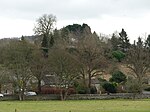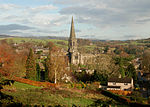Bakewell Bridge
BakewellBridges in DerbyshireGrade I listed buildings in DerbyshireHistory of DerbyshireScheduled monuments in Derbyshire

Bakewell Bridge is a Grade I listed stone arch bridge spanning the River Wye in Bakewell, Derbyshire. The bridge is also a scheduled monument.
Excerpt from the Wikipedia article Bakewell Bridge (License: CC BY-SA 3.0, Authors, Images).Bakewell Bridge
Bridge Street, Derbyshire Dales
Geographical coordinates (GPS) Address External links Nearby Places Show on map
Geographical coordinates (GPS)
| Latitude | Longitude |
|---|---|
| N 53.2144 ° | E -1.6728 ° |
Address
Bakewell Bridge
Bridge Street
DE45 1DU Derbyshire Dales
England, United Kingdom
Open on Google Maps











